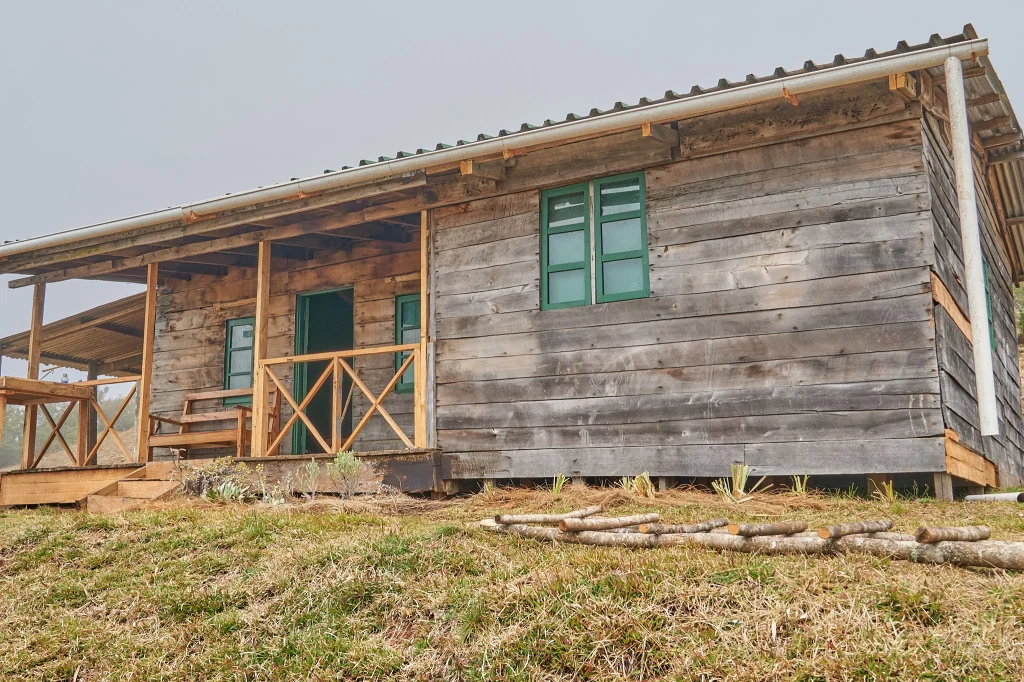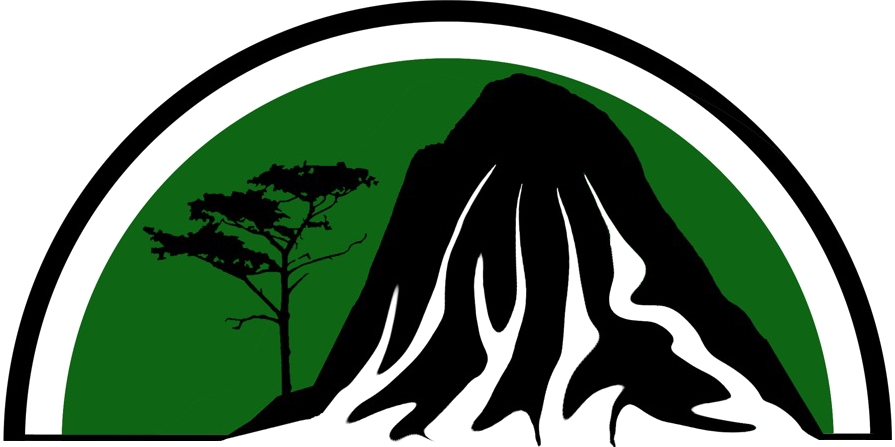James Roditi

They waited under the forest canopy in the early morning light. Samson had already taken control. In his red Adidas three stripe track suit, wrap around shades perched on his domed shaven head his hooded eye radiated authority. He paced about the bags piled on the elevated lawn in front of the old Ruo powerhouse. A small group of men were beginning to stack up roof sheets and floorboards against the whitewashed wall. The rest stood apart. There were several hundred of them. The youngest looked down from the road snaking up into the lower reaches of the Ruo Gorge whilst a few women looked up from nearer the river. The majority stood, restless, in a circle about us. They talked amongst themselves. More packs were brought from my car and added to the pile. Tents, clothes, some tools, and food. When we were ready Samson addressed the crowd.
Word had travelled around both Gambeya and Ndaonetsa villages that we were going to restore Minunu hut, a cabin at the top of the Ruo Gorge. The hut, abandoned by its watchmen, had been ransacked, and near destroyed several years ago by poachers. High winds had lifted off the roof. The floor inside had been stripped , revealing nothing but bare, black compacted earth. The walls and the ceiling were charred from fires lit in the centre of the room. The concrete fire mantel had fallen away and the only furniture left were two burnt bedframes.
In the weeks prior, we had gathered floorboards, roof sheets, cement, rebar, roof nails, regular nails (three inch and six inch), sugar soap, window frames, glass windows (cut almost to size) and a host of other supplies deemed necessary. The floorboards were salvaged from the decommissioned upper levels of the Lujeri Tea Factory and were tongue in grove Oregon pine from the early nineteen-hundreds. There were precious few complete boards with splintered tongues and groves caked with ancient tea dust. Everything was now stacked outside the power house, waiting for Samson to issue his instructions. In his hand he held a list of fifty names.
With a gruff call for it, he received silence and had their attention. He announced these names would be read out and when a name was called those who called it their own should come forward to collect a ticket on which it would be written along with what they would be carrying. The crowd murmured. When they reached the top, Samson continued, their ticket would be stamped received and they could then return down to the powerhouse to collect their pay. The crowd muttered. The guides, who had already set themselves apart with better clothes and a familiarity amongst themselves and about the assembled baggage were called first. Costa, Fred, Washington, Noel and several others collected their tickets and shouldered the lighter bags of clothes and tools. They set off. In their wake two carpenters. More names were read out, written on scraps of paper along with their load and dispatched. Kalema; ‘5 boards’. Chikonde; ‘bag of nails’. Maxwell; ‘8 panes of glass’. Six squat men pushed themselves forward, hessian sacks in hand. They divided up three 50kg bags of cement and, with faces powered white, and necks compressed with familiar burden, started the long ascent. Fifteen women were called all at once. They formed a line, gave their names and took the wide, green and unwieldly roof sheets. The first fifty had departed but the crowd remained. It closed in. Men were shouting their names. Samson pushed them back with a single barked order. They pressed in again, climbing up on remaining timber, again a bark, more forceful this time, then order. Then one by one they were selected until one hundred and thirty-six people were walking up the Ruo Gorge, with various parts of the hut balanced on their heads. Only few disgruntled teenagers and the local drunk were left without a morning’s work.
Everyone wanted to work. International governments were coordinating frantic national lock downs to stem COVID-19’s widening gyre. Malawi had shut its borders and people were cautious to travel within the country, adhering mostly to their own internal guidance. No one was coming to Mulanje. The guides and porters were the worst affected. It seemed like a good time to restore the hut and it was a much needed safety stop for those hiking and attempting the various peaks on the south central plateau.
By the time Samson and I had returned from the village headmen to coordinate a visit from the local Sing’anga, a traditional herbalist doctor, to bless the project, a few had already returned with stamped ticket in hand. It took them just over two hours to go up and down.
Up-top the mood was buoyant. Two tents had set up on the side of the hut whilst inside, where there was still water tight roof, a twelve strong team of carpenters and support had laid out their matts. Work had already started with materials, roof sheets, and assorted timber set out on the knoll in front of the hut. The roof came off in its entirety and then was pinned back on. It remained dry, fortunately, through the week. Spare roof sheets were beaten by a tinsmith (who had lugged up a car sump anvil and hammer) into watertight buckets and pails. The floor began, plank by plank, to extend across the floor after the new floor joists were set in on the bare earth. Missing cladding was replaced on the hut’s exterior walls and window frames and panes were painstakingly refitted. Bucket loads of stone and sand were fetched from the river to mix with the cement to repair the concrete fireplace mantel. Two men spent the days scrubbing the walls with sugar soap to remove the ingrained black soot. Additional supplies of longer roof nails, a Philips screwdriver, and two additional bottles of whiskey were sent up to general relief. It was thirsty work. Outside tables, benches, and a blanket box were remade and the cedar porch balustrades rebuilt – the old hacked ones cut out and set above the front window frames for posterity. Cedar planks, small and roughhewn, the remaining off cuts from once large, now vanished, cedar forests were bought by passing bare foot poachers to make the exterior repairs.

Next to the hut a cedar nursery was established and the two new hut watchmen, who prepared the daily meals for the crew, were tasked to tend to it. Several hundred cedar saplings sit in wait of planting in the denuded forest on the upper edge of the Ruo Gorge. The watchman’s hut, whose roof had also blown away, and whose windows had long since gone, and who knows what happened to their porch – it was probably burnt – was also restored over the week along with the long drop toilet and shower box walls.
Visitors came and went to remark on, cajole, advise, and celebrate the progress on the hut before either tackling one of the nearby sugar- domed granite peaks of Dzole, Khuto and Ndandalanda or sitting quietly to take in the view of the two small, glittering waterfalls across the swale.
On the final day, the Sing’anga came. The crew were told to step away so as not to bear witness as he blessed the hut. I waited down by the pools immediately below the hut. Two nesting turacos, their wings scarlet red, alighted from tree to tree. Upon returning I found one of the crew uncertain as to whether to continue cleaning graffiti off the walls that were now splattered with a slick green paste, part of the blessing rituals.
Eventually the floor was complete and could bear the weight of the table, benches, chairs, and our coming and going. The doors were painted green and affixed with new locks. The walls, though still flecked with black soot, winked a canary yellow of a former past during our celebratory candle lit dinner. The roof was on and watertight, and the glass windows opened and closed to the elements, which now gathered themselves once more. We descended, leaving the hut whole and giving the key to its new watchman, Clement, who now spends his days tending Cedar saplings, fetching water, and waiting for a weary walker to arrive.




